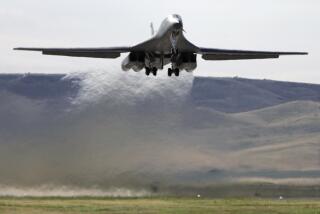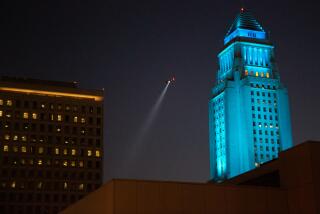Under His Wing : Colleague Defends Record of Pilot of TWA Flight 800
LAGUNA HILLS — In 31 years of flying for TWA, including the last several years evaluating other pilots, Robert Sackett has developed a keen eye for detail and a strong sense of what’s right.
The Laguna Hills resident was offended when he read remarks by an anonymous official of the Federal Aviation Administration after TWA Flight 800 plunged into Long Island Sound off New York last July 18, killing all 230 aboard.
The unnamed official had told reporters that the pilot of the doomed flight, Ralph G. Kevorkian of Garden Grove, had been under investigation by the FAA and faced a 30-day suspension for an incident in January.
Sackett knew what the official didn’t: Kevorkian, a safety-conscious stickler for procedure, had blown the whistle on himself.
Kevorkian had exercised “emergency authority” to risk landing an L-1011 jet, that at 358,000 pounds was 1.9% overweight, in St. Louis as a severe storm approached the city.
The alternative was to stay in the air long enough to dump 7,000 pounds of fuel and risk being diverted to New York, where he might face another possible weather delay low on fuel.
“This whole thing was really unfair to Ralph, who was one stalwart airman,” said Sackett. He said others at TWA also believe Kevorkian’s name should be cleared because the FAA official didn’t release Kevorkian’s side of the story.
“This was over nothing really, a technical violation, something that happens routinely,” Sackett said.
But, Sackett said, he and other pilots were irked far less by the investigation itself than the impression left by the official, whose remarks made it seem that Kevorkian had a blemished safety record.
What’s more, Sackett said, the official’s statements planted a subtle suggestion that pilot error might have have figured in Flight 800’s demise.
“A bunch of us are really bothered by this,” said Sackett, adding that aviation officials are frequently too quick to suggest pilot error as the cause of an airline disaster, before all the facts are known.
Kevorkian’s safety record was excellent, Sackett said. Like Sackett, Kevorkian was a TWA veteran who had logged more than 20,000 hours in the air, and was frequently chosen to evaluate his colleagues, a job known in industry parlance as “check pilot.”
Check pilots often observe cockpit crews during flights, quizzing them on procedures and scrutinizing their performance.
The task requires experienced, knowledgeable pilots and Kevorkian was no exception, Sackett said, recalling how Kevorkian required flight crews to examine the oxygen levels in their portable tanks, lest they end up in an emergency halfway to Europe and suddenly need a full tank.
Sackett said Kevorkian told him about the overweight landing and his report several weeks after the Jan. 2 incident, during a layover in Orlando, Fla.
FAA records released to The Times under the federal Freedom of Information Act show that shortly before Kevorkian’s Los Angeles-to-St. Louis flight took off, several late passengers and their luggage boosted the take-off weight by 10,000 pounds. With the concurrence of TWA’s flight dispatcher, Kevorkian took off with the extra weight rather than delay the flight to have some of it unloaded.
Kevorkian and the dispatcher believed excess fuel would easily be burned off before the flight reached Lambert Field in St. Louis, records show. Besides, that airport often experiences delays, Sackett said.
Under federal aviation regulations, pilots “in an emergency situation that requires immediate decision and action [can] deviate from prescribed operations, procedures and methods . . . to the extent required in the interest of safety.”
Kevorkian knew that the plane could safely land at weights up to 500,000 pounds--almost 150,000 pounds heavier than his landing weight--a TWA lawyer pointed out to the FAA.
Maximum landing weights are proposed by aircraft manufacturers and certified by FAA experts, said Diane Fuller, an agency spokeswoman in Renton, Wash.
After weighing the risks, Kevorkian decided to invoke his emergency authority and land.
On the Pilot’s Use of Emergency Authority form that Kevorkian later submitted, he wrote: “Landing overweight was as safe or safer than dumping fuel.”
Eric A. Overby, TWA’s managing attorney, wrote to FAA officials that, “Captain Kevorkian followed TWA procedures, which in turn fully complied with the [federal regulations] regarding this flight.”
Overby continued: “It would have been imprudent to dump fuel and guarantee substantial delays. As is stated in the old aviation axiom: ‘The most useless things are the runway behind you, altitude above you, and fuel left on the ground (or dumped!).”
The lawyer noted that Kevorkian “could see the storm approaching” and knew that if he waited, “the storm would encompass” St. Louis.
And it did. Right after Kevorkian landed, the next plane “executed a missed approach and [the airport] was then closed to all further landing traffic for several hours,” Overby wrote.
In July, after Kevorkian perished with 229 others on Flight 800, John Clabes, an FAA spokesman in Atlanta, told reporters of the pending investigation of Kevorkian.
Clabes said he merely read from the official FAA letter that had been sent to Kevorkian, and had no other details about the incident or Kevorkian’s record. Clabes added: “I had been told later that [Kevorkian] anticipated bad weather, but there wasn’t any.”
On the contrary. Kevorkian narrowly averted a winter storm that dumped 10 inches of snow on St. Louis, caused the cancellation of 200 TWA flights, delayed numerous others and closed area schools.
“Ralph said he was told they were going to drop the whole thing,” Sackett said. “Obviously, that didn’t happen.
“Being the astute check pilot, Ralph said, ‘I’m going to do the right thing,’ so he turned himself in,” Sackett said. “Most people I know would never have done that.”
More to Read
Sign up for Essential California
The most important California stories and recommendations in your inbox every morning.
You may occasionally receive promotional content from the Los Angeles Times.










